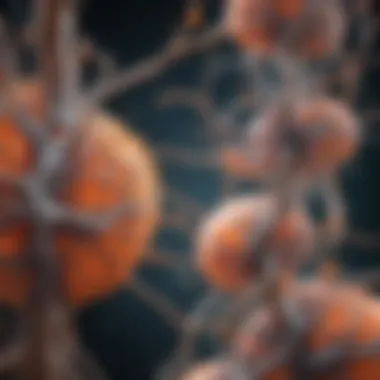Myelin Sheath Repair Mechanisms in Multiple Sclerosis


Intro
Multiple sclerosis (MS) is a complex neurological disorder that poses significant challenges for both patients and researchers alike. The disease primarily hinges on the damage to myelin sheaths, the protective coverings surrounding nerve fibers. With a deeper understanding of myelin sheath repair mechanisms, promises of restoring neurological function rise.
Understanding the underlying causes of this damage is critical. In MS, immune cells mistakenly attack the myelin, leading to communication difficulties within the nervous system. Current therapeutic approaches primarily aim at managing symptoms rather than addressing the root cause. However, ongoing research is shedding light on potential avenues for repairing these crucial structures and enhancing neurological health.
In this article, we will explore various aspects of myelin sheath repair, focusing on cellular processes, molecular interactions, and novel therapeutic strategies. The insights presented here aim to enrich the discourse in the field of neurology, particularly for students, researchers, educators, and professionals dedicated to combating multiple sclerosis.
Intro to Multiple Sclerosis
Understanding multiple sclerosis is pivotal for grasping not just the disorder itself, but also how it relates to the broader scope of neurological health. MS poses serious challenges, affecting the central nervous system and impairing the quality of life for many. Recognizing the significance of this topic sets the stage for an exploration into the mechanisms of myelin sheath repair, a critical aspect when addressing the complexities of the disease.
Multiple sclerosis occurs when the immune system erroneously attacks the protective myelin sheaths that cover nerve fibers, leading to a disruption in communication between the brain and the rest of the body. It’s like trying to listen to music on a radio with a faulty connection; the signal is all jumbled up, leading to misunderstandings and problems. Understanding MS, therefore, not only clarifies the disease itself but also helps frame discussions on repair strategies.
Defining Multiple Sclerosis
Multiple sclerosis is an unpredictable and often debilitating disease. In its essence, MS is characterized by patches of inflammation in the central nervous system that lead to demyelination, meaning the protective myelin layer around nerves is damaged. It manifests in various forms—relapsing-remitting MS is perhaps the most familiar, where patients face cycles of symptom flare-ups followed by remissions. Other types include primary progressive and secondary progressive forms, each bringing its unique challenges.
The symptoms can vary widely, ranging from fatigue and difficulty walking to numbness or vision problems. Each case is distinct, painting a varied picture that complicates diagnosis and treatment. In essence, defining MS is not just a matter of listing symptoms; it involves understanding its multifaceted nature and its profound impact on individuals' lives.
Epidemiology and Prevalence
When we delve into the epidemiology of MS, we're not just throwing numbers around; we're illuminating the scope of the issue. Globally, it's estimated that around 2.8 million people live with MS, but this figure is complex due to geographical variations. For example, MS is more prevalent in regions further from the equator, suggesting that environmental factors, possibly including Vitamin D levels or viral exposure, may play a role.
In different populations, the age of onset typically ranges between the ages of 20 and 50, although it can occur at any age. Gender plays a significant role too—women are diagnosed two to three times more often than men. This disparity raises intriguing questions about hormonal influence and genetics, inviting further research into the underlying causes.
"The understanding of the prevalence and diverse manifestations can help drive research, informing clinical practices and shaping the future of therapeutic approaches."
Overall, epidemiology helps us not only recognize patterns but also foresee educational and treatment needs, ultimately steering the focus towards effective management of MS.
The Structure and Function of the Myelin Sheath
Understanding the structure and function of the myelin sheath is crucial when discussing myelin repair in conditions like multiple sclerosis. The myelin sheath acts as insulation for axons, the long projections of neurons responsible for transmitting impulses. This protective layer not only speeds up signal transmission but also plays a role in maintaining the longevity of neurons. When myelin is damaged, as seen in multiple sclerosis, the subsequent loss of these protective benefits can lead to severe impairment in neurological function.
Anatomy of Myelin Sheath
The myelin sheath is composed primarily of lipids and proteins, forming a layered structure around the nerve fibers. In the central nervous system, oligodendrocytes create segments of myelin, while in the peripheral nervous system, Schwann cells take on this role. Each segment, or internode, is separated by small gaps called nodes of Ranvier, which are critical for the propagation of electrical signals.
- Components of Myelin Sheath:
- Lipids: Mainly cholesterol, sphingomyelin, and phospholipids contribute to its insulating properties.
- Proteins: Myelin basic protein and proteolipid protein are key examples that stabilize the sheath structure.
The arrangement of these components allows the myelin sheath to fulfill its role effectively. It's like wrapping a wire in plastic—without this insulation, electrical signals would leak, and communication within the nervous system would slow dramatically.
Role in Nervous System Function
The myelin sheath serves several indispensable roles within the nervous system.
- Increased Conduction Velocity:
One of the most significant advantages of myelin is its ability to allow electrical impulses to travel much faster along the axons. This is accomplished via a mechanism known as saltatory conduction, where the impulse jumps from one node of Ranvier to another, thus, speeding up transmission. - Energy Efficiency:
Myelinated axons require less energy to propagate signals compared to unmyelinated ones. The concentration of ion channels at the nodes minimizes energy loss, allowing neurons to send impulses more efficiently. - Protection and Support:
The myelin sheath provides structural support to the axon, protecting it from damage and maintaining its integrity. It's akin to having a sturdy backbone that enhances resilience during everyday activities and stressors.
"Without the myelin sheath, the speed of nerve impulses would be drastically reduced, leading to significant neurological consequences."
Mechanisms of Myelin Damage in Multiple Sclerosis
Understanding the mechanisms of myelin damage is a cornerstone in the study of multiple sclerosis (MS). This aspect is crucial as it sheds light on how the nervous system is affected and what potential strategies could be devised for repair. The insights gained from exploring these mechanisms can guide future research and facilitate the development of targeted therapies.
Autoimmune Response


The autoimmune response is a significant factor contributing to myelin damage in multiple sclerosis. In this scenario, the body's immune system mistakenly attacks its own myelin, a protective sheath surrounding nerve fibers. This misguided attack can lead to demyelination, which disrupts signal transmission—much like a frayed electrical wire.
The exact triggers for this autoimmune reaction remain elusive, but genetic predispositions and environmental factors appear to play a role. Exposure to certain viral infections, for instance, has been implicated in precipitating this aberrant immune activity in susceptible individuals.
Additionally, the molecular mimicry hypothesis suggests that certain foreign antigens share similarities with myelin components, prompting the immune system to attack myelin as if it were a pathogen. This response can lead to inflammation and further damage, exacerbating the clinical manifestations of MS.
"A better understanding of the autoimmune mechanisms could pave the way for innovative therapies that specifically target these erroneous immune responses."
Inflammatory Processes
Inflammation is another key component of myelin damage in MS. This process involves a cascade of events where immune cells infiltrate the central nervous system (CNS), exacerbating tissue damage. Activated microglia and macrophages release pro-inflammatory cytokines that not only contribute to myelin destruction but also influence the surrounding nerve tissue.
These inflammatory processes can create a vicious cycle; as myelin is damaged, more immune cells are drawn to the site, causing further injury. Chronic inflammation can result in lesions on the brain and spinal cord, leading to the characteristic neurological deficits experienced by individuals with MS.
Furthermore, factors such as oxidative stress may enhance the inflammatory response. Reactive oxygen species produced during inflammation can directly harm oligodendrocytes, the cells responsible for producing myelin, thereby impairing repair mechanisms.
In summary, the complex interplay between autoimmune reactions and inflammatory processes plays a critical role in myelin damage within multiple sclerosis. Understanding these mechanisms not only helps contextualize the challenges associated with repairing myelin but also highlights the potential pathways for innovative therapeutic interventions.
Cellular Players in Myelin Repair
The role of cellular players in myelin repair is fundamental in understanding multiple sclerosis and its treatment. These specialized cells—oligodendrocytes, microglia, and astrocytes—work in concert to restore the damaged myelin sheath, providing a pathway toward neurological recovery. Grasping the functions and interactions of these cells reveals why myelin repair is not only a biological challenge but also a crucial area for therapeutic advancements. Each type of cell has unique contributions, which are intertwined and complex, driving the overall process of repair.
Oligodendrocytes and Their Role
Oligodendrocytes are the star players in the myelin repair process. They are responsible for producing and maintaining the myelin sheath that insulates nerve fibers. In the context of multiple sclerosis, where myelin is damaged, these cells face a daunting task. When myelin is compromised, oligodendrocytes can become depleted, leading to further neurological damage. However, they have a remarkable ability to regenerate under certain conditions.
- Mechanisms of Action: Oligodendrocytes activate several repair mechanisms when they encounter nerve injury. They can remyelinate axons and possibly recruit additional oligodendrocytes from their precursor cells. This regeneration process is crucial, as it helps maintain the efficiency of neuronal signaling.
- Challenges in Repair: Despite their potential, oligodendrocytes often struggle in the inflammatory environment typical of MS. Factors such as pro-inflammatory cytokines can hinder their survival and function.
"Understanding how to support oligodendrocyte survival during inflammatory episodes can be a key to enhancing repair mechanisms in MS."
Role of Microglia
Microglia are the resident immune cells of the central nervous system and play a dual role in myelin repair. They are often called the "clean-up crew" because they can remove debris from damaged neurons and myelin, providing a more favorable environment for healing.
- Restorative Functions: In addition to cleaning, microglia can secrete factors that promote the growth and differentiation of oligodendrocyte precursor cells. This supportive role enhances the myelin regeneration process.
- Inflammation Mediation: However, they can also become overactivated during MS, turning from friends to foes. Their excessive activation leads to the release of inflammatory mediators, potentially exacerbating the damage to myelin. This balance between support and destruction is critical and reflects the complexity of their role in repair efforts.
Astrocytes and Neural Support
Astrocytes, also known as astroglia, are another pivotal contributor to myelin repair. They provide support and nutrition to neurons and help maintain the extracellular environment. Their involvement is often underestimated, but they are essential in managing the overall health of the nervous system.
- Protective Roles: Astrocytes help form the blood-brain barrier, which is vital in preventing further inflammation in the CNS. They can also release neurotrophic factors that promote neuronal survival and support oligodendrocyte function.
- Repair Regulation: Importantly, astrocytes can influence the repair process by modulating the activity of both oligodendrocytes and microglia. Their communication network is a lively system that balances repair and inflammation, demonstrating their significant role in overall neuroprotection.
Factors Influencing Myelin Repair
Understanding the elements that enhance or inhibit myelin repair is vital in the conversation about multiple sclerosis (MS). The journey towards effective therapies hinges on these factors, as they shape the dynamics of cellular repair mechanisms. Factors influencing the myelin infrastructure are often categorized into intrinsic and extrinsic, each wielding its own impact on the repair processes. Examining these dimensions is crucial for unraveling the intricacies of myelin sheath restoration and developing effective treatment strategies.
Intrinsic Cellular Factors
When delving into myelin repair, one cannot overlook the body’s internal cellular milieu. Intrinsic cellular factors, which encompass the properties inherent to the cells involved in myelin repair, play a monumental role. Oligodendrocytes, the primary cells responsible for producing myelin in the central nervous system, exhibit varying capacities for regeneration depending on their state in the disease process. For instance, those oligodendrocytes that are damaged or stressed might show diminished potential to repair the myelin sheath compared to their healthy counterparts.
Moreover, research indicates that cellular senescence—a state in which cells lose the capability to divide—can further complicate the repair landscape. This aging process may be exacerbated by chronic inflammation in MS, hindering the ability of oligodendrocytes to function effectively. Notably, factors such as growth factors, cytokines, and gene expression also influence the reparative actions of these cellular players. In some cases, modulation of intracellular signaling pathways can unlock new avenues for promoting myelin restoration.
To summarize, the internal biochemistry and behavior of cells directly affect the repair process. Understanding these intrinsic factors allows researchers to explore new ways to encourage effective myelination.
Extrinsic Environmental Factors
Now, shifting the spotlight to extrinsic environmental factors, which are equally significant. These elements are external influences that can affect myelin repair, spanning from physical conditions to the larger biological context in which these cells operate. For example, the overall health of an individual, including diet, exercise, and exposure to toxins, can all sway the repair mechanisms. That’s right, what goes into one’s body—or what one is subjected to in their environment—has ramifications that can’t be ignored.
Research has shown that anti-inflammatory diets can sometimes assist in alleviating symptoms and improving recovery rates. Moreover, stress levels play a crucial part since stress hormones can alter immune responses and impact repair efficacy.
Social determinants of health also come into play. Access to healthcare, social support networks, and economic stability can enable or limit the resources available for someone coping with MS.
In essence, the interplay between an individual's experiences and their surrounding environment creates a tapestry of influences that can either hinder or facilitate myelin repair. By giving attention to these conditions, the scientific community can start to forge strategies that are comprehensive and holistic, addressing the larger picture rather than merely focusing on cellular mechanisms in isolation.
"The environment not only shapes individuals but also influences the processes that matter most, such as health and recovery."
As we weave the insights from both intrinsic and extrinsic factors, it becomes increasingly clear that a multifaceted approach is necessary for advancing our understanding of myelin repair. The quest continues, revealing the depth and complexity of this biomedical puzzle.


Current Therapies for Myelin Repair
The landscape of treatments for myelin repair is evolving, driven by an imperative to improve the lives of individuals afflicted with multiple sclerosis. This section looks into the current therapies aimed at promoting myelin repair. Understanding these approaches not only sheds light on the latest scientific advancements but also addresses the pressing need for effective therapeutic options. The efforts to repair myelin are deeply intertwined with the persistent symptoms of MS, making them a cornerstone of contemporary neurological treatment strategies.
Immunomodulatory Approaches
Immunomodulatory therapies represent a significant segment of treatment modalities tailored to halt or reduce the progression of multiple sclerosis. These treatments function by modulating the immune system's activity to curb the destructive processes that lead to myelin damage.
Key elements of immunomodulatory therapies include:
- Beta-interferons: These are perhaps the most widely recognized agents in this category. They help to reduce the frequency of relapses and slow disease progression by influencing immune activity.
- Glatiramer acetate: This is designed to mimic myelin components, helping to redirect the immune response in a way that calms the inflammatory attack on myelin.
- Lymphocyte-depleting therapies: Such as alemtuzumab and ocrelizumab, which target specific immune cells involved in the inflammatory process of MS, thereby reducing systemic inflammation.
These therapies have shown benefits not only in reducing symptoms but also in fostering conditions favorable for myelin repair. However, considerations regarding their long-term effectiveness and potential side effects are necessary. The trials and studies conducted demonstrate a mixed outcome, with some therapies showing promise much more than others, leading the medical community to an ongoing quest for optimizing their efficacy.
Stem Cell Therapies
Stem cell therapies have emerged as a beacon of hope in reconsidering how to approach repair mechanisms in multiple sclerosis. This cutting-edge area of research capitalizes on the unique ability of stem cells to differentiate into various cell types, including oligodendrocytes, the catalysts for myelin production.
Stem cell therapies encompass several strategies:
- Hematopoietic stem cell transplantation (HSCT): Provides a way to reset the immune system completely using the patient's own stem cells, which aims to break the cycle of immune attack that damages myelin.
- Mesenchymal stem cells (MSCs): Often derived from bone marrow or fat tissue, these cells possess immunomodulatory properties and have shown potential in promoting repair beyond just remyelination.
- Induced pluripotent stem cells (iPSCs): Derived from adult cells that have been reprogrammed to an embryonic-like state, iPSCs can also give rise to oligodendrocytes, serving as a source for myelin regeneration.
The application of stem cell therapies is not without risks and complexities. Challenges include the potential for immune rejection and the variability in patient responses. Furthermore, logistical aspects around sourcing, processing, and administering these cells continue to complicate the landscape.
"Stem cell therapies signal a transformative shift in addressing underlying degenerative processes in multiple sclerosis, pushing the boundaries of traditional treatment paradigms."
Ultimately, the trajectory of both immunomodulatory and stem cell therapies for myelin repair underscores a hybrid approach, merging biological insight with therapeutic innovation. As ongoing research unveils further details regarding the mechanisms of action and the circumstances under which these therapies flourish, the potential to harness their benefits fully offers hope for those grappling with the profound challenges posed by multiple sclerosis.
Emerging Research in Myelin Repair
The investigation into myelin repair plays a crucial role in understanding and potentially treating multiple sclerosis (MS). As researchers delve deeper into the field, the emergence of new methodologies and concepts could transform how we approach this pervasive neurological disorder. By harnessing innovative strategies, particularly through pharmacological agents and gene therapy, the hope is to instigate regeneration in myelin sheaths, enhancing both quality of life and neurological function for individuals living with MS.
Novel Pharmacological Agents
Research in this area has sparked interest in the development of novel pharmacological agents that target myelin regeneration. Several compounds are being designed to stimulate oligodendrocyte precursor cells, which are integral to myelin formation.
These agents often focus on specific pathways:
- Growth factor modifiers: These substances regulate the expression of proteins that promote cell growth and repair.
- Immune modulators: By managing the immune response, these therapies prevent the further degradation of myelin, allowing for a more conducive environment for repair.
Among notable candidates, ethyl pyruvate and clemastine serve as examples. Ethyl pyruvate exhibits neuroprotective qualities, particularly by reducing inflammation. Clemastine, on the other hand, has shown potential in promoting remyelination in animal models and is currently under clinical evaluation.
"New pharmacological agents signify a turning point, offering the possibility of rejuvenating damaged tissue and restoring function."
However, the path to integrating these agents into clinical practice isn't without hurdles. The need to establish optimal dosages, understand potential side effects, and navigate regulatory pathways can challenge researchers.
Gene Therapy Approaches
Gene therapy is yet another intriguing frontier in the quest for myelin repair. With advancements in genetic engineering techniques, such as CRISPR-Cas9 and viral vector delivery systems, scientists can now contemplate direct modifications to the genetic material that governs myelination.
The focus here is on:
- Restoring or replacing defective genes: Some variations of MS may be linked to genetic anomalies affecting myelination. Gene therapy aims to correct these defects.
- Enhancing production of myelin-specific proteins: By upregulating these proteins, researchers can stimulate the natural repair processes within the nervous system.
Initial trials have shown promise, particularly in preclinical studies involving animal models. However, the ethical considerations regarding gene editing remain a matter of debate. Potential risks, including unintended mutations or immune reactions, necessitate extensive evaluations before these therapies can be applied to human subjects.
Challenges in Myelin Repair Research


Myelin repair in multiple scleroses faces a mountain of hurdles, each one adding layers of complexity to an already intricate problem. As we delve into the heart of myelin sheath restoration, it’s crucial to understand these challenges. Grasping these difficulties not only sharpens our perspective on research progress but also paves the way for future therapeutic advancements.
Biological Complexity of Repair Mechanisms
The biological world often resembles a tightly woven tapestry, where each thread contributes to the grand picture. In the case of myelin repair, this tapestry is woven from a myriad of cellular interactions and molecular pathways. The complexity of these systems is rivaled only by their importance.
First, the restoration of myelin requires the coordinated action of various cell types, including oligodendrocytes, microglia, and astrocytes. These cells must communicate seamlessly to promote repair. However, disruptions in these signaling pathways can derail attempts at remyelination. For instance, an overactive inflammatory response from microglia can hinder the myelination process, creating a paradox where damage overwhelms repair.
Moreover, the repair mechanisms are not universally applicable. One molecular response might work wonders in one context but could be detrimental when it comes to another. Understanding these intricacies is essential. Scientists are continuously piecing together the puzzles surrounding different repair strategies, yet much remains to be explored.
"The road to myelin repair is not just a straight path but a labyrinth of biological interactions, each requiring careful navigation."
Across the Spectrum of MS
Multiple sclerosis presents itself as a heterogeneous disorder, where each patient’s experience can be vastly different. This variation complicates research into myelin repair considerably. Not all patients exhibit the same symptoms or the same patterns of myelin damage. Some may endure extensive lesions while others show relatively little, despite similar clinical presentations.
- A few factors that contribute to this variability include:
- Genetic predisposition
- Environmental influences
- Disease subtype and progression patterns
The challenge is that therapies effective for one subgroup may not hold the same benefits for another. Thus, research must adopt a more personalized approach, considering each patient’s unique genetic and environmental background. Moreover, longitudinal studies are essential to assess the long-term efficacy of potential treatments in diverse populations.
As research teams forge ahead, the need for robust models that accurately represent the spectrum of MS cannot be overstated. It is through these models that we can begin to decipher the unique pathways that lead to successful myelin repair, addressing the nuances that current generic approaches often overlook.
In summary, the challenges in myelin repair research are multifaceted. They involve intricate biological mechanisms and a spectrum of patient responses. Only by confronting these challenges can we hope to forge pathways to more effective treatments.
Future Directions in Myelin Repair Studies
The exploration of myelin sheath repair in multiple sclerosis (MS) is a developing field of study, and understanding future research directions is paramount. The process of repairing myelin can be likened to fixing a frayed electrical wire; the integrity of the signal carries significant implications for the overall functionality of the nervous system. Recognizing the importance of these directions not only lays a foundation for future research but also highlights the potential benefits that may arise for patients suffering from MS.
Understanding Cell Signaling Pathways
Cell signaling pathways play a crucial role in regulating the repair mechanisms of the myelin sheath. These pathways are responsible for facilitating communication between cells, guiding how they respond to various stimuli. In the context of MS, a disorder characterized by autoimmune attacks against myelin, understanding the intricate web of signaling molecules can open up new avenues for therapeutic strategies.
Research indicates that certain growth factors and cytokines can influence the behavior of oligodendrocytes, the cells responsible for myelin production. For example, signaling molecules like brain-derived neurotrophic factor (BDNF) have shown promise in promoting the survival and differentiation of these cells. Thus, studying the nuances of these signaling pathways not only helps us comprehend the biological mechanisms at play but also may encourage the development of drugs that modulate these factors. Moreover, the exploration of negative regulators, which can impede myelin repair, may yield insights into potential therapeutic targets that enable enhanced regeneration.
Translating Research into Clinical Practice
Translating research findings into clinical practice remains a challenge yet is indispensable for advancing treatments in myelin repair. The process can often resemble trying to fit a square peg into a round hole; researchers frequently grapple with the complexities of human biology and the distinct responses exhibited by patients. Therefore, establishing collaborations among basic scientists, clinicians, and industry players is vital.
One promising strategy is the integration of findings from preclinical studies into clinical trials. For instance, a successful strategy observed in mice may not always yield similar results in humans due to biological differences. Researchers need to ensure robust designs in clinical trials that take these disparities into account.
Furthermore, patient-specific treatments based on biomarker profiles or genetic information can enhance therapeutic precision and ultimately improve efficacy. Personalized medicine, which tailors treatment to the individual’s unique condition, has the potential to usher in an era of more effective strategies in managing MS and accelerating myelin repair.
"The transition from bench to bedside is fraught with challenges, yet it is the bridge that transforms scientific discovery into tangible patient benefits."
Finale
In concluding our exploration of myelin sheath repair in multiple sclerosis, it becomes clear that we face a multifaceted challenge. This condition not only affects individual patients but also poses considerable hurdles in the field of neurology as a whole. Understanding the mechanisms through which the myelin sheath is compromised and subsequently repaired is essential. Such knowledge not only impacts treatment approaches but also offers hope for improved quality of life for those affected.
Summary of Findings
Throughout the article, several key findings emerged:
- Myelin Damage Mechanisms: We delved into the biological processes that lead to myelin damage, particularly autoimmune responses and inflammatory processes. These factors disrupt the normal function of oligodendrocytes, the cells responsible for myelin production.
- Cellular Players in Repair: Oligodendrocytes, microglia, and astrocytes play vital roles in the repair process. Understanding the interactions between these cells amplifies our grasp of potential therapeutic targets.
- Therapeutic Strategies: Advances in immunomodulatory treatments and pioneering stem cell therapies appear promising, as they aim to enhance remyelination in afflicted individuals.
- Emerging Research: With the introduction of novel pharmacological agents and gene therapy approaches, we find ourselves on the cusp of breakthroughs that could reshape treatment paradigms.
Implications for Treatment
The implications of our findings are profound. As researchers and practitioners deepen their understanding of the cellular and molecular intricacies of myelin repair, several considerations emerge:
- Personalized Medicine: It may become feasible to tailor treatments based on individual biological profiles. This could optimize therapeutic efficacy while minimizing side effects.
- Translational Research: Bridging the gap between laboratory discoveries and clinical applications remains critical. Continued investment in translational studies will be essential to ensure that advancements benefit patients directly.
- Holistic Approaches: Emphasizing a comprehensive toolkit involving lifestyle changes, physical therapies, and pharmacological interventions could support recovery more effectively than isolated strategies alone.
"The intricate dance of cellular repair processes holds the key to unlock better interventions for those with multiple sclerosis."
Ultimately, the exploration of myelin sheath repair is not only about therapeutic advancements, but it also invites a broader understanding of neurological health. The journey forward demands collaboration across disciplines to untangle this complex issue, for the benefit of those living with multiple sclerosis.







